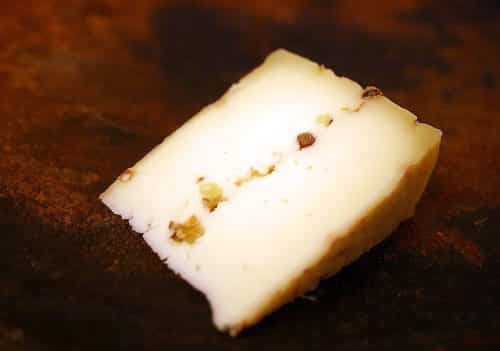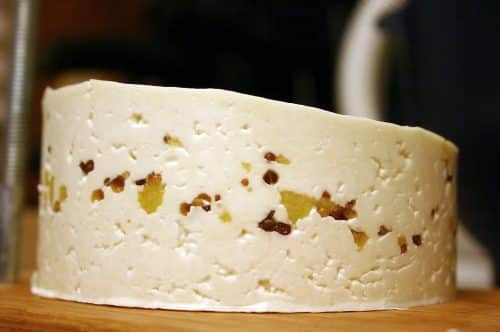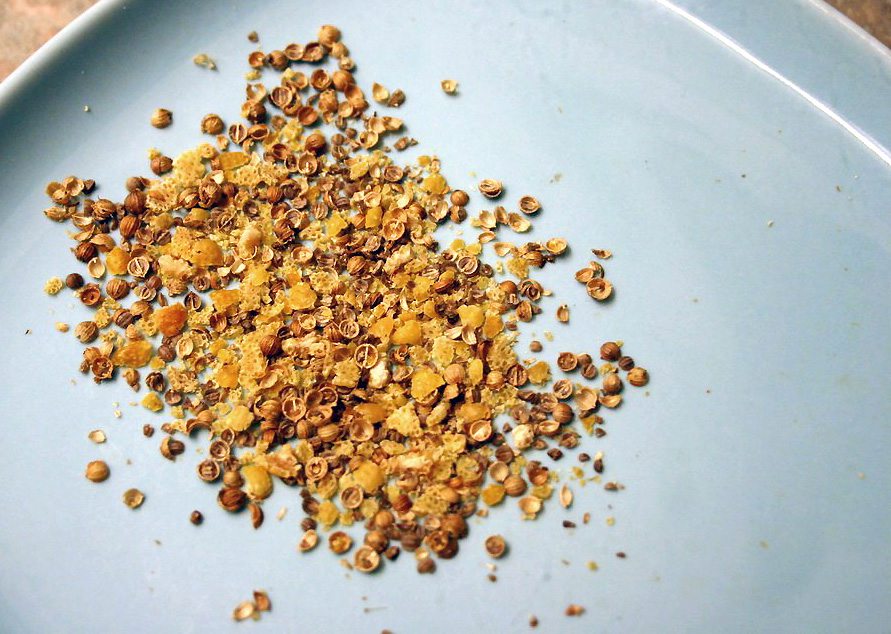This is the 10th month of the world wind Cheesepalooza challenge and there is only 1 more month to go after. I have to say I have learned so much since I began this cheese adventure. I have learned to try and be as precise as possible (I am bad at it), I have learned patience, I learned to not throw in the towel after failures, and I learned to make cheese at home.

This month our challenge was a washed rind cheese. This means once the cheese is made and aging, you wash the rind with a brine like solution on a regular basis so it forms a flavor packed rind.

I chose an Ale Washed Trappist Cheese from the Making Artisan Cheese at Home book. The milk was infused with coriander seeds and lemon peel.

Also a layer of the two was placed between the curd for extra flavor.
My cheese wash was made with a mix of brine and of white Belgian beer.

Although the inside of the cheese tastes good, my washed rind did not turn out like it should have. It did not have the pungent odor know to this cheese, not did I get the firm, flavorful rind around the cheese. I think some bad bad bacteria got in there with the good bacteria. Just had to cut the rind off before consumption.

Ale Washed Trappist Cheese
Ingredients
- 2 gallons pasteurized milk
- 3 tsp coriander seeds crushed
- 3 tsp granulated orange peel
- ½ tsp Meso II starter
- ½ tsp calcium chloride diluted in ¼ cup nonchlorinated water
- ½ tsp liquid rennet diluted in ¼ cup nonchlorinated water
- Kosher salt
- Two 12 oz bottles of Belgian Ale at room temperature plus 16 to 24 oz more for washing
Instructions
- In a nonreactive 4 quart saucepan, heat 2 quarts of milk over low heat to 90°F; this should take about 20 minutes. Stir in 2 teaspoons of the coriander and 2 teaspoons of the orange peel, then slowly raise the temperature to 110°F over the course of 10 minutes. Turn off the heat, cover, and let steep for 45 minutes.
- Place the remaining 1-1/2 gallons of milk in a nonreactive pot. Pour the steeped milk through a fine mesh strainer into the larger pot of milk and whisk to combine. Discard the coriander and orange. Bring the milk to 90° over low heat; this should take 5 minutes. Turn off the heat.
- Sprinkle the starter over the milk and let it rehydrate for 5 minutes. Mix well with an up and down stirring motion. Cover and maintain 90°F for 30 minutes. Add the calcium chloride and gently stir for 1 minute, then add the rennet the same way. Cover and let sit for 1 hour, or until the curds give a clean break.
- Still maintaining 90°F, cut the curds into ½ inch pieces and let sit for 10 minutes. The curds will shrink to the size of small beans. Meanwhile, heat 1 gallon of water to 175°F. Ladle off enough whey to expose the curds. Add enough hot water to bring the temperature to 93°F. Stir for 10 minutes. Repeat this process of removing whey and adding hot water, this time bringing the temperature to 100°F. Stir for 15 minutes, then let the curds settle for 10 minutes. Cover and let rest for 45 minutes, maintaining 100°F. The curds will mat and form a slab.
- Drain off enough whey to expose the slab of curds. Transfer the slab to a flat bottomed colander, place it over the pot, and let drain for 5 minutes. Transfer the slab to a cutting board and cut into 3/8-inch thick slices. Place in bowl and gently toss with 2 teaspoons of the salt.
- Line two 5-inch molds with damp cheesecloth and set on draining rack. Tightly pack a quarter of the curds in each mold, and press at 5 lbs for 10 minutes, just to compact the curds slightly. Peel back the cloth and sprinkle each cheese with ½ tsp of coriander and ½ tsp of orange peel, then pack in the rest of the curds. Press at 8 lbs of pressure for 6 hours at room temperature. Remove the cheese, flip over and rewrap. Press at 8 lbs of pressure for 8 hours.
- Pour the bottle of ale into a lidded, non reactive container large enough for ale and cheese. Remove the cheese from the mold and place it in the ale. Soak the cheese, covered, for 8 hours at 55°F, flipping over once.
- Remove the cheese from the ale and pat dry. Reserve and refrigerate the ale and place the cheese on a cheese mat. Air dry at room temperature for 12 hours. Return the cheese to the ale and soak for another 12 hours at 55°F. Remove, pat dry, and air-dry at room temperature for 12 hours, or until the surface is dry to the touch. Discard the ale.
- Prepare a brine-ale wash: boil ½ cup of water and let it cool, and combine with ½ cup of ale, then dissolve 1 teaspoon of salt in it. Store in the refrigerator.
- Place the cheese on a mat in a ripening box and ripen at 50°F and 90% humidity for 4 to 6 weeks. Flip the cheese daily for the first 2 weeks, then twice weekly after that. After each flip, pour a little brine-ale wash into a small dish, dip a small piece of cheesecloth in it, and use it to wipe the surface of the cheese. Discard any unused brine-ale wash after 1 week and make a fresh batch. Also wipe away any moisture from the bottom, sides, and lid of the ripening box each time you flip the cheese.




This one looks great too! Ours tasted very very bitter.. I thought it might have been from the coriander. Congrats on your cheese success 🙂
You are so good at this Evelyne! I can’t even dream of making something as good as this at home. It looks like its bought from a gourmet store. Well Done!
What a fun challenge it is! Your cheese looks gorgeous and very impressive! I love the wonderful flavors you add in them especially using Belgian Ale! 🙂
I haven’t ventured past mower real and ricotta. Kudoa to you.
Holy moly! That is just too cool. Once I got over my initial amazement that you made this, I really appreciated the extra layers of flavor 🙂
oh my goodness looks incredible! Cheese obsessed!
I’m so impressed with all your cheesemaking…yay you! This particular one sounds super interesting, too!
WOW!! I am so totally impressed 🙂 I have to make these and I keep forgetting to ask you about it when I see you! Must be all the champagne :). Kudos baby, you rock.
It still looks good, I hope it did not discourage you, washed rind cheeses are my favourite to make. There is a challenge for month 12.
OMG Evelyne! You have no idea how much I wanted to be making all these fabulous cheeses! This looks spectacular!
Gosh..you are an expert in cheese-making!
Oh, my. What an amazing cheese. It seriously does not look homemade! I can’t believe you are almost done with this challenge! I’m so impressed with all you’ve accomplished.
I think I’m more interested in the beer than the cheese. Don’t think I’ve had anything from Belgium or even a white ale before.
Wow! Great looking cheese.. Loved the detail in the post.. I’m a new blogger… Do visit my blog.. http://kitchenserenity.blogspot.in/
Already 10th month!? Wow, so fast and I cannot believe how far you’ve come, and you are so pro now… I’m really impressed by your positive thinking and have inspired us a lot! I’m loving your can-do attitude and I really wish to try making my own one day.
Eve, you are amazing! You really push yourself with these cheeses and yet you make it so striaghforward for the rest of us to try it. Thank you!! 😀